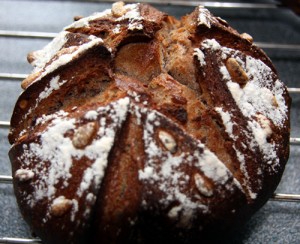
[:fr] Pain corse à la farine de chataîgne et aux pignons de pin[:en] Chestnut and pine nuts Corsican bread
Les chataîgnes sont un ingrédient essentiel de la cuisine Corse. Pendant longtemps, les moyens de communication et le transport des marchandises entre l’île et le continent étant limités, les habitants de la Corse n’étaient pas autosuffisants en blé. Les chataîgnes étant très abondantes dans les forêts, ils remplacaient une partie de la farine de blé par de la farine de chataîgnes. C’est la raison pour laquelle un Corse le chataîgner est aussi appelé « arbre à pain ». Aujourd’hui la farine de chataîgne est restée dans les recettes traditionelles Corses et elle donne aux pains et pâtisseries un goût inimmittable.
Ingrédients
- 200 g de farine de blé
- 150 g de farine de châtaigne
- 1 sachet de levure de boulangerie
- 18 cl d’eau tiède
- 1 pincée de sel
- 2 cuillères à soupe de pignons de pin
Préparation
- Dans un saladier ou dans votre machine à pain, mélangez les farines, la levure et le sel.
- Incorporez l’eau tiède. Pétrissez le mélange à la main pour obtenir une pâte homogène. Incorporez les pignons de pin.
- Laissez reposer la pâte 1h30 dans un endroit tiède.
- Préchauffez le four (210°C).
- Façonnez la pâte en boule et posez-la sur une plaque de cuisson recouverte de papier sulfurisé. Couvrez avec du papier film légèrementl huilé et laissez lever 30 min de plus.
- Faites 4 ou 5 incisons dans le pain, couvrez d’un film d’eau que vous appliquez au pinceau et parsemaz de farine blanche.
- Faites cuire au four 10 minutes a 210°C puis 20 minutes a 180°C.
Bonu appitittatu![:en]
Recipe

Chestnut flour is very important in Corsican cuisine because in the old days, when means of communication with the continent were rare and expensive, the Corsican did not have enough wheat on the island to reach self-sufficiency. As a consequence, to replace wheat flour they used chestnut flour because chestnut trees are very abundant in Corsican forests. That is the reason why in Corsica most people call the chestnut tree « arbre à pain » (bread tree). Today chestnut is still omnipresent in Corsican food and gives breads and pastries a unique taste.
Ingredients
- 200 g strong white bread flour
- 150 g chestnut flour
- 1 teaspoon dry active yeast
- 18 cL lukewarm water
- 1/3 teaspoon salt
- 2 tablespoons pine nuts
Preparation
- Put the flour in your bread machine or a salad bowl. Make a small indent in the middle and put the water and yeast. Put salt in a corner (no contact with the yeast – very important)
- Mix all together, add the pine nuts and work the dough for about 15 minutes.
- Leave the dough to rest covered, in a warm place, for 1h30.
- Knock down the dough and shape it into a round bread.
- Leave to rise, covered with lightly oiled cling film, for 30 minutes.
- Preheat the oven (210°C).
- Cut 4 or 5 lines in the bread, glaze with a bit of water and sprinkle with white bread flour.
- Put in the oven. Cook the first 10 minutes at 210°C and then 20 minutes at 180°C.
Bonu appitittatu! (means « Bon appétit » in Corsican language)
Nutrition
 This bread has quite a healthy profile. As any bread, it is mainly made of flour, as a consequnce carbohydrates, so it is very energetic. This is good if you practice exercice. If not, first you should do and second, you should limit the amount of carbohydrates you eat because otherwise your body will not be able to « burn » this energy, leading to weight gain.
This bread has quite a healthy profile. As any bread, it is mainly made of flour, as a consequnce carbohydrates, so it is very energetic. This is good if you practice exercice. If not, first you should do and second, you should limit the amount of carbohydrates you eat because otherwise your body will not be able to « burn » this energy, leading to weight gain.
In addition to this, this bread contains good levels of fiber,vitamins and minerals compared to a basic white bread thanks to the chestnut flour.
Environment
Greenhouse gas emissions

This recipe generates low greenhouse gas emissions.
Wine match








Commentaires
Non surtout ne pas mélanger la levure et le sel en même temps
La levure au début du pétrissage
Le sel en fin de pétrissage
PS : sinon le sel détruit la levure
Amitiés à Tutti basgi